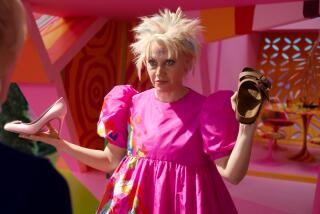Doll in Chair Looks Like Grandmother She Really Was : Collecting: Elderly black matron peers through wire-rimmed glasses at National Doll Festival. She and other ethnic dolls now appear regularly beside flaxen-haired, blue-eyed Southern belles.
- Share via
PHILADELPHIA — Among the nipped waists, Victorian dresses and vacant porcelain faces sitting pretty at the National Doll Festival, there was Ms. Louise.
Seated on a wooden chair with a bag of groceries, the elderly black matron peered through her wire-rimmed spectacles and leaned forward, poised to tell a thing or two about life.
“She’s based on my husband’s grandmother,” said artist Rose Mary King of Lexington, Ky. “She would come out of her room and would always be all dressed up with her hat and her pearls. She would go to the store and be all dressed up.”
But where Ms. Louise and her pointed glance might once have been a rare sight in the doll world, she and other ethnic dolls now appear regularly beside flaxen-haired, blue-eyed Southern belles.
While ethnic dolls have always been available, their demand has increased in recent years, festival director Rowbear Lowman said.
“Particularly in the past five years, there has been an appreciation,” Lowman said. “And with new materials and techniques, dolls are more lifelike than ever.”
King, who works full-time at a windshield factory, says it was this kernel of reality that drew her into the doll-making world. “The other dolls I saw, they weren’t done by African-American artists, and they didn’t look like people I knew,” she said.
Although mirror images of real people are increasingly popular, the svelte Barbie Doll is still very big, according to Lowman. About one-third of the 300 exhibit tables set up at the Pennsylvania Convention Center recently were devoted to the cult figure, who celebrated her 35th birthday this year.
But don’t tell that to Edna Tkachuk of Speedway, Ind., founder of Soft Sculpture Dolls. Her creations wouldn’t be caught dead in Barbie’s penthouse pool.
Instead of razor-edge features, Armani dresses and impossible measurements, Tkachuk’s chubby characters dress in sloppy blue sweats, holding a weight-loss book in one hand and an Oreo cookie in the other.
“I know that doll. I see her every morning,” said avid doll collector Meg Hardis with a laugh. “But I’m holding potato chips.”
Artists and retailers said they don’t know why doll reality is suddenly as attractive as fantasy. But they know that, like fantasy, reality doesn’t come cheap.
“Our dolls range from $100 to $1,000,” said Barbara Whiteman, whose Philadelphia-based company Dark Images sells only black dolls. “I look for artists who use lifelike images, from a real ballerina to this baby doll who has a naturally sleepy look.”
When King first took Ms. Louise on the road for her first doll exhibition last October, her wire-and-clay dolls sold for $80 apiece.
Ten months later, and pleasantly surprised, King can collect $500 and up for the figures that take at least 40 hours to construct.
Such a creature is 7-year-old Puck, dressed in a stoplight yellow raincoat, pulling a wagon full of junk. He’s based on King’s brother Phillip, who as a grown-up still brings home treasures no one else wants.
“I know them, so they’re hard to let go sometimes,” said King, fondly stroking one of her clay creations. “I had one doll named Bubba, who was an old man. He liked to lay around on the couch. He was really hard to see go.”
More to Read
The biggest entertainment stories
Get our big stories about Hollywood, film, television, music, arts, culture and more right in your inbox as soon as they publish.
You may occasionally receive promotional content from the Los Angeles Times.










